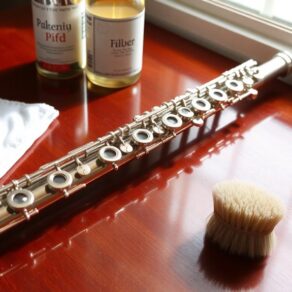To troubleshoot common flute problems, start by checking for sticky keys. Clean or replace pads as necessary and verify key alignment. Assess your sound; focus on proper embouchure and breath control for clarity. Look for cracks in the headjoint, making sure it's aligned with the flute body. If tuning is off, adjust the headjoint position and check your airflow. Regular maintenance is key—clean your flute after each play and oil pads semi-annually. For persistent issues, don't hesitate to consult a professional. There's more information available that can enhance your flute care techniques and improve your playing.
Key Takeaways
- Inspect for sticky keys; clean or replace pads and check for moisture or misalignment issues.
- Ensure proper embouchure and breath control to improve unclear or weak sound production.
- Check for visible cracks or dents in the headjoint; seek professional repairs if necessary.
- Adjust headjoint position and practice with a tuner to improve tuning and intonation.
- Maintain regular cleaning and inspection of pads, and schedule annual professional check-ups.
Sticky Keys and Mechanism Issues

When dealing with sticky keys and mechanism issues on your flute, it's essential to identify the root cause quickly.
Start by inspecting the sticky pads. If they're dirty or worn, you may need to clean or replace them. Use a soft cloth to wipe the pads and the key mechanism. If cleaning doesn't resolve the issue, check for moisture buildup, which can cause pads to stick.
Next, examine key alignment. Misaligned keys can lead to improper pad seating, causing a sticky feel. Gently press each key to see if they engage smoothly. If you notice any misalignment, you might need to adjust the key height or alignment. A proper adjustment guarantees the pads seal correctly against the tone holes.
Lastly, listen for any unusual noises when you play. This could indicate further mechanism issues. Regular cleaning with a flute cleaning kit can help maintain your instrument and prevent such problems. If you're unsure about the adjustments, consulting a professional technician can provide peace of mind.
Unclear or Weak Sound

A common issue many flute players encounter is unclear or weak sound, which can stem from several factors.
First, examine your sound production technique. Make sure you're forming a proper embouchure; your lips should be firm yet relaxed, directing the air stream accurately into the flute. Adjusting your angle and position can greatly enhance sound quality.
Next, consider your breath control. Insufficient airflow can lead to a weak tone. Practice breathing exercises to strengthen your diaphragm and increase your airflow capacity. When you play, aim for a steady, supported airstream. This consistency is essential for achieving a clear sound. Additionally, mastering breath support is crucial for producing a rich and resonant tone.
Also, check your flute's condition. Any dirt or moisture buildup can impact sound quality. Regularly clean your flute and make certain there are no obstructions in the tone holes.
Finally, don't underestimate the importance of practice. Spend time honing your sound production and breath control techniques. Incorporate long tones and dynamic exercises into your routine to improve clarity and strength.
Cracked or Damaged Headjoint

Inspecting your flute's headjoint for cracks or damage is vital to maintaining peak sound quality. A compromised headjoint can severely affect your flute's responsiveness and tonal quality.
Start by examining the headjoint closely for any visible cracks or dents. If you spot any imperfections, consider them a priority for headjoint repair.
Next, confirm that the headjoint is properly aligned with the body of the flute. Misalignment can further exacerbate sound issues, leading to an unclear or weak tone.
To check alignment, gently play long tones while observing the sound's consistency. If you notice fluctuations, it's time to address potential misalignment.
If you encounter significant damage, it's best to consult a professional repair technician. They can assess the extent of the damage and perform necessary repairs, guaranteeing that your headjoint is restored to ideal condition.
While minor imperfections might be manageable, don't hesitate to seek expert assistance for more serious issues. Remember, a well-maintained headjoint is vital for achieving the rich, vibrant sound you desire. Regular maintenance, including using key oil and cork grease, can also help preserve the functionality of your flute.
Prioritize these checks regularly to keep your flute in peak performance.
Problems With Tuning

After ensuring your flute's headjoint is in good condition, you may notice tuning issues that can affect your overall performance. Start by checking your flute's intonation; if it feels off, you might need to make some tuning adjustments.
Play a series of long tones to identify specific notes that sound sharp or flat compared to a tuner or a piano. If you find certain notes consistently out of tune, consider adjusting the position of the headjoint. Pulling it out slightly can lower the pitch, while pushing it in can raise it.
Make small adjustments and test the intonation again, as even minor changes can greatly impact your sound. If you're still facing intonation issues, examine your embouchure and airflow. Sometimes, adjusting your air direction or tightening your embouchure can help center your pitch.
Practice matching pitches with a tuner, focusing on maintaining a steady tone. Lastly, remember that environmental factors like temperature and humidity can also affect tuning. Regularly changing your flute pads can also enhance your tone and prevent sound leaks, which will improve your practice sessions.
Regularly checking your flute and making necessary tuning adjustments will enhance your performance and keep you connected with your instrument and fellow musicians.
Maintenance and Care Tips

To keep your flute in ideal playing condition, regular maintenance is essential. Incorporating effective cleaning techniques and routine checks can greatly extend the life of your instrument. Here are some key practices to follow:
| Maintenance Task | Frequency |
|---|---|
| Clean the flute body | After each use |
| Inspect pads | Monthly |
| Oil pads | Every 6 months |
| Professional check-up | Annually |
After playing, use a cleaning rod and cloth to remove moisture from the inside of the flute. This helps prevent buildup that can affect sound quality. Inspect the pads for wear and tear; if they appear discolored or sticky, it's time to evaluate replacement. Oiling pads guarantees they remain flexible and responsive, contributing to a smoother playing experience. Regular cleaning with a flute cleaning kit ensures effective maintenance and hygiene for your instrument.
Remember to store your flute in a protective case when not in use to prevent damage. By adopting these maintenance habits, you'll foster a deeper connection with your instrument and enhance your musical journey. Regular care not only benefits your flute but also creates a sense of belonging in the musical community.
Frequently Asked Questions
How Often Should I Replace My Flute Pads?
You should replace your flute pads based on their lifespan, which typically ranges from 3 to 10 years, depending on usage and care.
If you play frequently, you'll want to check them annually for wear. Look for signs like air leaks or sticky pads.
Regular maintenance helps guarantee peak performance.
Don't wait too long; replacing worn pads can prevent further damage and keep your flute sounding its best.
Can Humidity Affect My Flute's Performance?
Absolutely! High humidity can cause pads to swell, leading to leakage and poor sound quality.
Conversely, low humidity may dry out pads, making them brittle and prone to cracking.
Regular flute maintenance is essential; check your instrument in different environments.
If you notice changes in tone or response, consider adjusting your storage conditions to maintain ideal humidity levels for your flute's longevity and playability.
What Type of Cleaning Cloth Is Best for My Flute?
When choosing a cleaning cloth for your flute, opt for microfiber or cotton materials. These cloths effectively absorb moisture without scratching your instrument's surface.
Employing proper cleaning techniques is essential; use the cloth to wipe down the exterior gently after each use and guarantee you clean the pads carefully to prevent buildup.
How Do I Know if My Flute Needs Professional Servicing?
You'll know your flute needs professional servicing if you notice specific flute symptoms.
If it produces a fuzzy sound, sticks, or has an uneven response, these are clear repair signs.
Additionally, if you observe leaks around the pads or if the keys don't close properly, it's time to seek help.
Regularly checking for these issues guarantees your instrument stays in peak condition, helping you feel confident in your playing.
Are There Specific Storage Tips to Prevent Flute Damage?
To keep your precious flute in excellent condition, you'll want to treat it like royalty.
Always store it in a sturdy flute case that offers protection from bumps and drops. Aim for a climate-controlled environment, avoiding extreme temperatures and humidity. This helps prevent issues like warping or pad damage.
Regularly check your case for any signs of wear, ensuring your flute enjoys a safe and cozy home between those melodious sessions.
Conclusion
In conclusion, troubleshooting common flute problems doesn't have to be intimidating. By addressing sticky keys, sound issues, and tuning problems methodically, you can restore your flute's performance. You might think these issues require a professional, but many can be resolved with a bit of patience and the right approach. Regular maintenance and care will not only enhance your playing experience but also prolong the life of your instrument, ensuring that you continue to enjoy making music.






